Tomato products are widely available. They are nutritious, flexible, inexpensive, and simple to prepare. But what’s the connection between passata, tomato puree vs and tomato sauce, and when should you utilize which?
While passata means ‘puree’ in Italian, there is a substantial difference between ‘our’ tomato puree and Italian passata. Passata is a thick sauce with a sweet and creamy texture that is used as a basis for soups and conventional sauces.
Tomato puree is often cooked and peeled, and it must be deacidified before it releases its ultimate flavor. Passata’s tomatoes are (typically) cold pureed and so uncooked. Passata can also be used in place of ripe, canned, or glass tomatoes.
The concentrated tomato processing can be obtained in tiny cans or tubes. This spice should be quickly cooked to give forth its strong flavor. To flavor a meal, you don’t need much tomato puree. Tomato puree lends body and color to sauces, soups, and stews due to its thick consistency and rich red color. Or do actual Italian mothers utilize it as well? Well…
Tomato sauce is more fluid than tomato puree and is frequently served with pasta. Sauces are often pre-seasoned with spices, herbs, and vegetables including chili, oregano, basil, onion, and garlic.
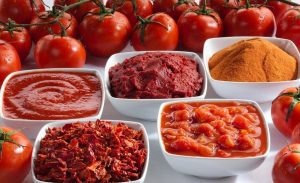
You may simply make your tomato sauce by diluting tomato puree with a little water while warming it and adding herbs, spices, and other ingredients yourself. Allow it to thicken to the desired sauce thickness by slowly bringing it to a boil.
tomato paste vs puree
Tomato purée and paste are both created from boiled and mixed tomatoes and are frequently used to season and thicken soups, stews, and sauces. Tomato paste is a thick cooking sauce manufactured from pureed tomatoes. To produce tomato paste, cook the tomatoes first, then drain and recook them.
This results in a thick, concentrated paste with the body, sweetness, and less acidity than puréed tomatoes. Tomato paste is used to thicken numerous tomato soups, stews, sauces, and ground meat meals such as meatballs, meatloaf, and tacos.
Tomato purée is a purée made from cooked and strained tomatoes. Tomato purée has a rich, tangy flavor that is formed by blending or processing ripe tomatoes, salt, and citric acid (similar to lemon juice). Purée is commonly offered as a canned tomato product; however, you may prepare it yourself with ripe plum or Roma tomatoes.
As you can see there are, though, some significant distinctions between tomato puree and paste. Their consistency is not the same. Tomato paste is thicker in texture than tomato purée. Tomato paste is a concentrated paste that must be spooned or squeezed from its container.
Tomato purée is more liquid and thinner, similar to a blended sauce. Tomato puree is occasionally formed from a combination of tomato paste and water, whilst paste can be made from decreased purée.
Another point to highlight is that they are cooked differently. Tomato paste and puree are both created from cooked and strained tomatoes, respectively.
Tomato paste, on the other hand, is heated longer and reduced to a concentrate after the water evaporates. Tomato purée is a blended tomato combination that is thicker than a sauce but not as thick as a paste.
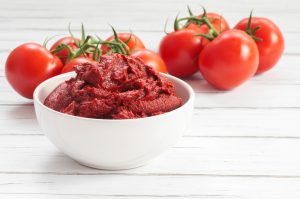
The final point is that they are employed in diverse ways. With a few tweaks, puree and paste can be used similarly, although tomato paste is often retained for thickening tomato sauces (such as producing marinara sauce) or adding seasoning to pasta sauce or pizza sauce. Tomato purée is used to produce numerous Italian sauces, including pizza sauce, as well as sauce-based condiments such as salsas and dips.
tomato paste vs sauce
There are several distinctions between tomato paste and tomato sauce. The only thing they have in common is that they are both manufactured from tomatoes. Though both are pantry staples produced from cooked and strained tomatoes, tomato paste is a thick tomato concentrate, and tomato sauce is a thick tomato sauce.
Tomato paste, as opposed to tomato sauce, has a more concentrated taste, and a thicker texture, and is used to complement other flavors in recipes. Unlike tomato sauce, the paste serves as a foundation component to create rich tastes rather than as the ‘tomato’ element in recipes.
A spoonful of tomato paste makes a big difference, which is surprising. It is a rich concentration prepared from cooked tomatoes that have lost all of their liquid.
Tomato sauce, on the other hand, does not have the same concentration. It comprises short-cooked tomatoes in a moderate amount of liquid and may be used to produce a wonderful sauce for pasta, pizza, meatballs, and other dishes. The texture of tomato sauce and tomato paste is one of the primary distinctions.
Tomato sauce is quite runny. If you pour it onto a dish, it will soon spread. Tomato paste, on the other hand, has a thick consistency. Tomato paste, on the other hand, includes more than 24% tomato solids.
The thickness of the tomato paste is determined by the manufacturing process. Tomatoes are cooked for so long that the water content evaporates, leaving a thick paste behind.

Both goods contain peeled tomatoes. Seeds are also taken out. Tomato paste has a flavor comparable to dried tomatoes. It has a pronounced acidity that tomato sauce does not have. The latter has a flavor similar to fresh tomatoes. Since tomato paste is so concentrated, it tastes like flesh.
It is frequently used in meals to provide an umami taste or to improve the flavor of other ingredients. Tomato paste is often regarded as having exceptional taste potential. If a recipe requires one teaspoon of tomato paste, no more should be added. A tiny bit of this paste adds a blast of flavor to the meal.
passata vs tomato paste
The primary distinction between passata and tomato paste is that passata is an uncooked and strained tomato paste, whereas tomato paste is a cooked super-concentrated tomato paste.
On the market, there are two types of tomato products: passata and tomato paste. Tomato paste is cooked, whereas passata is not. This adds a fresh flavor to passata and intensifies the flavor of tomato paste. Furthermore, tomato paste is thicker in consistency than passata.
Passata, often known as tomato passata, is made from uncooked and discolored tomatoes. In the United States, it is also known as tomato puree. Passata is made entirely of tomato — there are no flavorings or additions. Passata is smoother than crushed tomatoes because it has been drained of seeds and peel. Some passatas, however, might be chunkier depending on the brand.
Passata may be used to produce rapid pasta sauces and soups, particularly when cooking time is limited. It’s ideal for dishes that demand a fresh tomato flavor rather than a cooked-down flavor.
Passata is an Italian dish that is popular across Europe. Passata was once difficult to come by in some areas, but it is currently becoming increasingly prevalent at grocery shops. If you can’t locate passata in your local grocery shop, tomato puree is the finest option.
Tomato paste is a thick paste formed by slowly boiling tomatoes and squeezing off the seeds and peeling them. To produce tomato paste, just simmer tomatoes for a few hours to reduce their water content, remove the peel and seeds from the combination, and continue to boil until the mixture thickens and becomes rich.
Store-bought tomato paste frequently contains a stabilizer such as citric acid and salt, as well as herbs and spices. Most tomato pastes are manufactured at industrial factories. There are also tomato pastes that are double and triple concentrated on the market.

The percentage of tomato pastes is typically between 18 and 28 percent. For example, 5-6 kilograms of tomatoes are required to create 1 kg of tomato paste. Tomato paste, in general, is a component that helps in providing color and flavor to dishes. They are ideal for foods requiring extended cooking durations, such as beef sauce, soups, and stews.
tomato paste versus tomato puree
The main ingredient in tomato purée and paste is the same. However, thesome key differences distinguishese two ingredients:
To make tomato purée, lightly cook tomatoes and then purée the softened product into a liquid. Tomato paste, on the other side, is cooked for a longer time than puréed tomato paste.
Before being cooked again to reduce the concentrate into a thick paste, the cooked tomatoes are strained to remove the seeds and skins. Tomato purée has a much thinner consistency than tomato paste.
If you poured a can of purée into a cold pan, it would spread out and fill the pan like a thick broth. If you empty a can of paste into an unheated pan, it will stay mostly intact due to its firm consistency.
Tomato purée has a sweeter, milder, and more natural tomato flavor. Tomato paste is frequently used to thicken sauces or flavor soups and stews. Tomato purée is the foundation for thin tomato-based sauces and condiments such as salsas, hot sauce, marinara sauce, and pizza sauce.
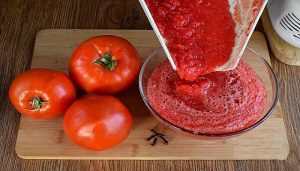
The products that have not been altered can be utilized interchangeably. In a pinch, you can make DIY tomato purée by diluting tomato paste with water or tomato juice, but you can’t make tomato paste from tomato purée.
tomato paste from diced tomatoes
You may be asked for diced tomatoes, tomato paste, crushed tomatoes, whole peeled tomatoes, and so on, depending on the recipe.
So, what’s the difference between all of these canned tomato varieties? Is it possible to replace a can of crushed tomatoes with a can of diced tomatoes, for example? Or perhaps your grocery store’s shelves are depleted of all canned tomatoes except the stewed variety. You’ve never before purchased stewed tomatoes. So, what exactly are stewed tomatoes?
Friends, we have answers and can guide you on your canned tomato journey!
Prior to canning, diced tomatoes are chopped and then processed with calcium chloride and citric acid to keep their shape. As a result, they’re firmer than whole or crushed tomatoes, so you’d think the smaller pieces would break down faster in cooking, but the opposite is true!
Diced tomatoes are ideal for recipes that require visible, tasty tomato chunks after cooking, such as beef chili or taco soup (especially if you choose a fire-roasted variety! ), fish stew, and chickpea curry, or baked shrimp in feta sauce.
If you use diced tomatoes instead of whole or crushed tomatoes, keep in mind that you may need to increase the cooking time to break down the tomatoes—and even then, they won’t break down completely. If you prefer, you can puree them in a food processor or blender.

Homemade tomato sauce should not be made with diced tomatoes.
Cook the tomatoes until all of the juice has evaporated and the tomatoes have developed a dark red color and concentrated flavor.
Tomato paste is used in a variety of recipes, including vegetable lentil soup, where it’s frequently added right after the chopped onions, garlic, celery, or carrots have caramelized in the oil and added a wonderful savory note as well as a bit of thickening. It’s extremely versatile and a must-have! Tomato paste can be used in place of tomato sauce if thinned with water.
tomato paste from diced tomatoes
Tomato paste, which is made from a thick mixture of diced tomatoes that have been cooked down for hours, gives recipes a concentrated flavor without watering them down. It’s usually found next to the canned tomatoes in small cans or tubes, and it’s a versatile ingredient for soups, stews, sauces, and more.
Don’t worry if you start a recipe and notice you don’t have tomato paste in your pantry or refrigerator. Make one of these at-home substitutions and add it to your grocery list. In a short period of time, canned tomato sauce can be transformed into a tomato paste substitute. If at all possible, start with ordinary (unseasoned) tomato sauce.
In a saucepan, bring a small can (8 ounces) of tomato sauce to a boil over medium heat. Cook for about 7 minutes, or until the liquid has been reduced by about two-thirds, stirring constantly. To prevent a disaster as the mixture thickens, use a splatter screen.
From an 8-ounce can of tomato paste, you should get about 3 ounces. You can also utilize a larger can of tomato sauce, but it will take longer to decrease the mixture by at least two-thirds.
To create tomato paste, you can also utilize a can of whole or diced tomatoes. In a blender or food processor, puree a 14.5-ounce can of tomatoes until smooth.
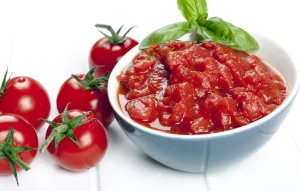
In a saucepan, bring the tomato mixture to a boil over medium heat. Cook for another 10 minutes, stirring constantly until the sauce has thickened and reduced by about two-thirds.
A 14.5-ounce can of tomatoes yields approximately 2/3 cup or 6 ounces of tomato paste. You can also make less tomato paste by using fewer canned tomatoes. Purée the canned tomatoes, using only half of the can, and reduce for 7 to 10 minutes. You can save the remaining purée for another time or freeze it for later use.


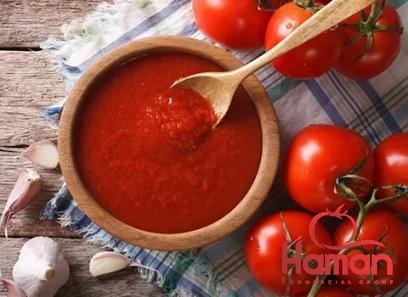
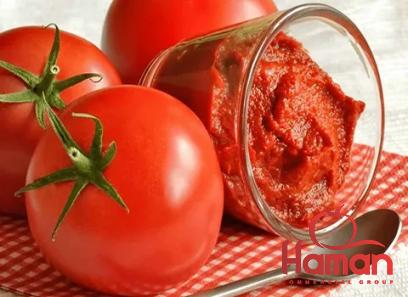
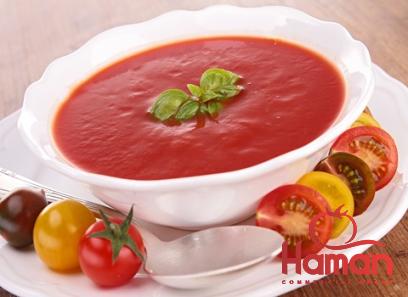

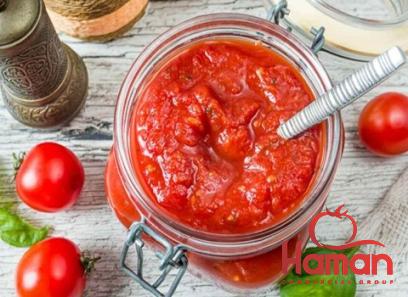
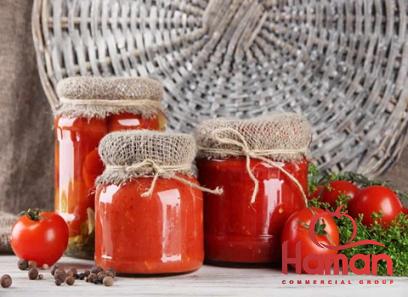
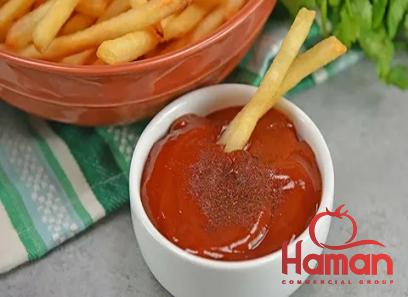
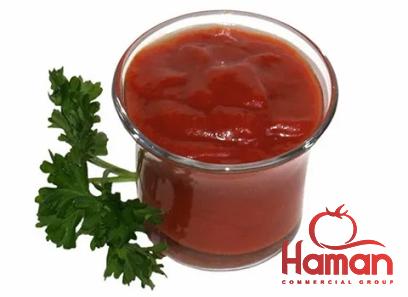
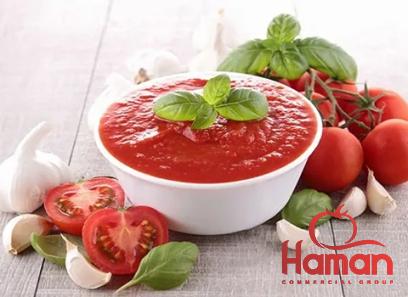
Your comment submitted.